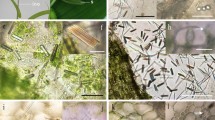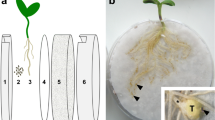Abstract
Haustoria of santalaceous root parasites examined have unusual tracheary elements containing granules within their lumina. Benson (1910) thought the granules were starch and that the cells also contained an enucleate protoplast. She believed the cells combined the functions of phloem and xylem conduits and so named them “phloeotracheides” (sic). In contrast, our research has shown the cells are dead at maturity and that the granules arise during ontogeny from the endoplasmic reticulum and are proteinaceous. We have re-named the cells graniferous trancheary elements.
Similar content being viewed by others
References
Anderson, W.A., André, J.: The extraction of some cell components with pronase and pepsin from thin sections of tissue embedded in an Epon-Araldite mixture. J. Microscopic 7, 343–354 (1968)
Benson, M.: Root parasitism in Exocarpus (with comparative notes on the haustoria of Thesium). Ann. Bot. (O.S.) 24, 667–677 (1910)
Ferrarini, E.: Il parassitismo di Osyris alba L. Nuovo Gi. bot. ital. 57, 351–381 (1950)
Fineran, B.A.: Studies on the root parasitism of Exocarpus bidwillii Hook. f. III. Primary structure of the haustorium. Phytomorphology 13, 42–54 (1963)
Fineran, B.A.: Studies on the root parasitism of Exocarpus bidwillii Hook f. V. Early development of the haustorium. Phytomorphology 15, 10–25 (1965)
Fineran, B.A.: A study of ‘phloeotracheids’ in haustoria of santalaceous root parasites using scanning electron micrsocopy. Ann. Bot. (N.S.) 38, 937–946 (1974)
Gori, P.: Protein bodies in the nucellus of Euphorbia helioscopia. J. Ultrastruct. Res. 54, 53–58 (1976)
Mazia, D., Brewer, P.A., Alfert, M.: The cytochemical staining and measurement of protein with mercuric bromophenol blue. Biol. Bull. 104, 57–67 (1953)
Moss, E.H.: Parastism in the genus Comandra. New Phytol. 25, 264–276 (1926)
Rao, L.N.: Parasitism in the Santalaceae. Ann. Bot. (N.S.) 6, 131–150 (1942)
Simpson, P.G., Fineran, B.A.: Structure and development of the haustorium in Mida salicifolia. Phytomorphology 20, 236–248 (1970)
Thiéry, J.P.: Mise en évidence des polysaccharides sur coupes fines en microscopie électronique. J. Microscopie 6, 987–1018 (1967)
Weber, H.C.: Anatomische Studien an den Haustorien (Kontaktorganen) von Thesium-Arten (Santalaceae). Ber. Deutsch. Bot. Ges. 90, 439–458 (1977)
Author information
Authors and Affiliations
Rights and permissions
About this article
Cite this article
Fineran, B.A., Juniper, B.E. & Bullock, S. Graniferous tracheary elements in the haustorium of the santalaceae. Planta 141, 29–32 (1978). https://doi.org/10.1007/BF00387740
Received:
Accepted:
Issue Date:
DOI: https://doi.org/10.1007/BF00387740




